 W
WGas-discharge lamps are a family of artificial light sources that generate light by sending an electric discharge through an ionized gas, a plasma. Typically, such lamps use a noble gas or a mixture of these gases. Some include additional substances, like mercury, sodium, and metal halides, which are vaporized during startup to become part of the gas mixture. In operation, some of the electrons are forced to leave the atoms of the gas near the anode by the electric field applied between the two electrodes, leaving these atoms positively ionized. The free electrons thus released flow onto the anode, while the cations thus formed are accelerated by the electric field and flow towards the cathode. Typically, after traveling a very short distance, the ions collide with neutral gas atoms, which transfer their electrons to the ions. The atoms which lost an electron during the collisions ionize and speed toward the cathode while the ions which gained an electron during the collisions return to a lower energy state while releasing energy in the form of photons. Light of a characteristic frequency is thus emitted. In this way, electrons are relayed through the gas from the cathode to the anode. The color of the light produced depends on the emission spectra of the atoms making up the gas, as well as the pressure of the gas, current density, and other variables. Gas discharge lamps can produce a wide range of colors. Some lamps produce ultraviolet radiation which is converted to visible light by a fluorescent coating on the inside of the lamp's glass surface. The fluorescent lamp is perhaps the best known gas-discharge lamp.
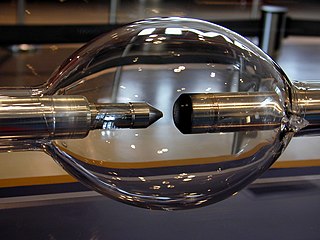 W
WAn arc lamp or arc light is a lamp that produces light by an electric arc. The carbon arc light, which consists of an arc between carbon electrodes in air, invented by Humphry Davy in the first decade of the 1800s, was the first practical electric light. It was widely used starting in the 1870s for street and large building lighting until it was superseded by the incandescent light in the early 20th century. It continued in use in more specialized applications where a high intensity point light source was needed, such as searchlights and movie projectors until after World War II. The carbon arc lamp is now obsolete for most of these purposes, but it is still used as a source of high intensity ultraviolet light.
 W
WThe ceramic discharge metal-halide (CDM) lamp, often referred to as Ceramic Metal Halide lamp (CMH) is a source of light that is a type of metal-halide lamp which is 10-20% more efficient than the traditional quartz metal halide and produces a superior color rendition.
 W
WA cold cathode is a cathode that is not electrically heated by a filament. A cathode may be considered "cold" if it emits more electrons than can be supplied by thermionic emission alone. It is used in gas-discharge lamps, such as neon lamps, discharge tubes, and some types of vacuum tube. The other type of cathode is a hot cathode, which is heated by electric current passing through a filament. A cold cathode does not necessarily operate at a low temperature: it is often heated to its operating temperature by other methods, such as the current passing from the cathode into the gas.
 W
WA compact fluorescent lamp (CFL), also called compact fluorescent light, energy-saving light and compact fluorescent tube, is a fluorescent lamp designed to replace an incandescent light bulb; some types fit into light fixtures designed for incandescent bulbs. The lamps use a tube which is curved or folded to fit into the space of an incandescent bulb, and a compact electronic ballast in the base of the lamp.
 W
WA crackle tube is a type of plasma lamp that is used most commonly in museums, night clubs, movie sets, and other applications where its appearance may be appealing for entertainment. Such a device consists of a double walled glass tube with a hollow center. The cavity between the inner and outer glass tubes is filled with thousands of small phosphor coated glass beads. A 5–14 kV transformer produces a low power gas discharge in the bead filled cavity, producing filaments of light that simulate lightning. Crackle tubes get their name not because of the sound they produce but rather because of the appearance of their internal behavior. The "lightning" is forced around and in between the phosphor-coated glass beads, due to the beads' dielectric nature. In so doing, the phosphor is excited by the electrical energy and fluoresces producing visible light. Like plasma globes, crackle tubes respond to touch; the filaments appear to be "attracted" toward the point of contact and usually become more luminous (brighter) as the electricity is grounded. The tubes are also filled with a noble gas like neon, argon, or xenon which acts as the electron transfer medium of the cavity. The gas is typically below atmospheric pressure.
 W
WA Crookes tube is an early experimental electrical discharge tube, with partial vacuum, invented by English physicist William Crookes and others around 1869-1875, in which cathode rays, streams of electrons, were discovered.
 W
WA deuterium arc lamp is a low-pressure gas-discharge light source often used in spectroscopy when a continuous spectrum in the ultraviolet region is needed.
 W
WAn electrical ballast is a device placed in series with a load to limit the amount of current in an electrical circuit.
 W
WThe internal electrodeless lamp or induction lamp is a gas discharge lamp in which an electric or magnetic field transfers the power required to generate light from outside the lamp envelope to the gas inside. This is in contrast to a typical gas discharge lamp that uses internal electrodes connected to the power supply by conductors that pass through the lamp envelope. Eliminating the internal electrodes provides two advantages:Extended lamp life Ability to use higher-efficiency light-generating substances that would react with internal metal electrodes in conventional fluorescent lamps
 W
WA flashtube, also called a flashlamp, is an electric arc lamp designed to produce extremely intense, incoherent, full-spectrum white light for very short durations. Flashtubes are made of a length of glass tubing with electrodes at either end and are filled with a gas that, when triggered, ionizes and conducts a high voltage pulse to produce the light. Flashtubes are used mostly for photographic purposes but are also employed in scientific, medical, industrial, and entertainment applications.
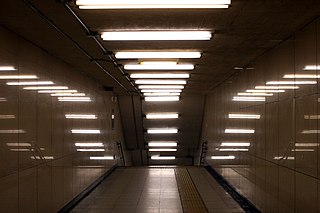 W
WA fluorescent lamp, or fluorescent tube, is a low-pressure mercury-vapor gas-discharge lamp that uses fluorescence to produce visible light. An electric current in the gas excites mercury vapor, which produces short-wave ultraviolet light that then causes a phosphor coating on the inside of the lamp to glow. A fluorescent lamp converts electrical energy into useful light much more efficiently than incandescent lamps. The typical luminous efficacy of fluorescent lighting systems is 50–100 lumens per watt, several times the efficacy of incandescent bulbs with comparable light output.
 W
WFluorescent lamps have been suggested to affect human health in various ways.
 W
WSince their introduction as a commercial product in 1939, many different types of fluorescent lamp have been introduced. Systematic nomenclature identifies mass-market lamps as to overall shape, power rating, length, color, and other electrical and illuminating characteristics.
 W
WA Geissler tube is an early gas discharge tube used to demonstrate the principles of electrical glow discharge, similar to modern neon lighting. The tube was invented by the German physicist and glassblower Heinrich Geissler in 1857. It consists of a sealed, partially evacuated glass cylinder of various shapes with a metal electrode at each end, containing rarefied gasses such as neon, argon, or air; mercury vapor or other conductive fluids; or ionizable minerals or metals, such as sodium. When a high voltage is applied between the electrodes, an electrical current flows through the tube. The current dissociates electrons from the gas molecules, creating ions, and when the electrons recombine with the ions, the gas emits light by fluorescence. The color of light emitted is characteristic of the material within the tube, and many different colors and lighting effects can be achieved. The first gas-discharge lamps, Geissler tubes were novelty items, made in many artistic shapes and colors to demonstrate the new science of electricity. In the early 20th century, the technology was commercialized and evolved into neon lighting.
 W
WA germicidal lamp is an electric light that produces ultraviolet C (UVC) light. This short-wave ultraviolet light disrupts DNA base pairing, causing formation of pyrimidine dimers, and leads to the inactivation of bacteria, viruses, and protozoa. It can also be used to produce ozone for water disinfection.
 W
WA glow discharge is a plasma formed by the passage of electric current through a gas. It is often created by applying a voltage between two electrodes in a glass tube containing a low-pressure gas. When the voltage exceeds a value called the striking voltage, the gas ionization becomes self-sustaining, and the tube glows with a colored light. The color depends on the gas used.
 W
WA glow switch starter or glowbottle starter is a type of preheat starter used with a fluorescent lamp. It is commonly filled with neon gas or argon gas and contains a bimetallic strip and a stationary electrode. The operating principle is simple, when current is applied, the gas inside ionizes and heats a bimetallic strip which in turn bends toward the stationary electrode thus shorting the starter between the electrodes of the fluorescent lamp After a second the starter's bimetallic strip will cool and open the circuit between the electrodes and the process repeats until the lamp has lit. One disadvantage of glow switch starters is that when the lamp is at the end of its life it will continuously blink on and off until the glow switch starter wears out or an electrode on the fluorescent lamp burns out.
 W
WHigh-intensity discharge lamps are a type of electrical gas-discharge lamp which produces light by means of an electric arc between tungsten electrodes housed inside a translucent or transparent fused quartz or fused alumina arc tube. This tube is filled with noble gas and often also contains suitable metal or metal salts. The noble gas enables the arc's initial strike. Once the arc is started, it heats and evaporates the metallic admixture. Its presence in the arc plasma greatly increases the intensity of visible light produced by the arc for a given power input, as the metals have many emission spectral lines in the visible part of the spectrum. High-intensity discharge lamps are a type of arc lamp.
 W
WA hollow-cathode lamp (HCL) is type of cold cathode lamp used in physics and chemistry as a spectral line source and as a frequency tuner for light sources such as lasers. An HCL takes advantage of the hollow cathode effect, which causes conduction at a lower voltage and with more current than a cold cathode lamp that does not have a hollow cathode.
 W
WIn vacuum tubes and gas-filled tubes, a hot cathode or thermionic cathode is a cathode electrode which is heated to make it emit electrons due to thermionic emission. This is in contrast to a cold cathode, which does not have a heating element. The heating element is usually an electrical filament heated by a separate electric current passing through it. Hot cathodes typically achieve much higher power density than cold cathodes, emitting significantly more electrons from the same surface area. Cold cathodes rely on field electron emission or secondary electron emission from positive ion bombardment, and do not require heating. There are two types of hot cathode. In a directly heated cathode, the filament is the cathode and emits the electrons. In an indirectly heated cathode, the filament or heater heats a separate metal cathode electrode which emits the electrons.
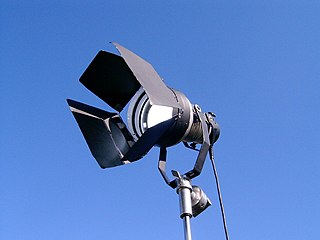 W
WHydrargyrum medium-arc iodide (HMI) is the trademark name of Osram's brand of metal-halide gas discharge medium arc-length lamp, made specifically for film and entertainment applications. Hydrargyrum comes from the Greek name for the element mercury.
 W
WMany of the installations of sulfur lamps were for testing purposes only, but there remain a few sites where the lamps are in use as the primary lighting source. Perhaps the most visible of these would be the glass atriums in the National Air and Space Museum.
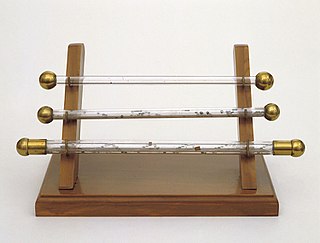 W
WThe luminous discharge tubes is part of an electric machine.
 W
WA mercury-vapor lamp is a gas-discharge lamp that uses an electric arc through vaporized mercury to produce light. The arc discharge is generally confined to a small fused quartz arc tube mounted within a larger borosilicate glass bulb. The outer bulb may be clear or coated with a phosphor; in either case, the outer bulb provides thermal insulation, protection from the ultraviolet radiation the light produces, and a convenient mounting for the fused quartz arc tube.
 W
WA metal-halide lamp is an electrical lamp that produces light by an electric arc through a gaseous mixture of vaporized mercury and metal halides. It is a type of high-intensity discharge (HID) gas discharge lamp. Developed in the 1960s, they are similar to mercury vapor lamps, but contain additional metal halide compounds in the quartz arc tube, which improve the efficiency and color rendition of the light. The most common metal halide compound used is sodium iodide. Once the arc tube reaches its running temperature, the sodium dissociates from the iodine, adding orange and reds to the lamp's spectrum from the sodium D line as the metal ionizes. As a result, metal-halide lamps have high luminous efficacy of around 75–100 lumens per watt, which is about twice that of mercury vapor lights and 3 to 5 times that of incandescent lights and produce an intense white light. Lamp life is 6,000 to 15,000 hours. As one of the most efficient sources of high CRI white light, metal halides as of 2005 were the fastest growing segment of the lighting industry. They are used for wide area overhead lighting of commercial, industrial, and public places, such as parking lots, sports arenas, factories, and retail stores, as well as residential security lighting and automotive headlamps.
 W
WA plasma globe or plasma lamp is a clear glass container/ball filled with a mixture of various noble gases with a high-voltage electrode in the center of the container.
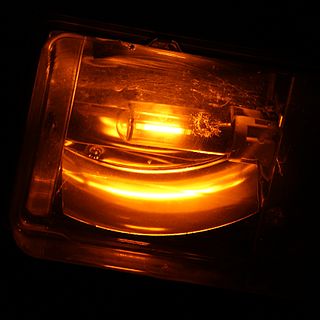 W
WA sodium-vapor lamp is a gas-discharge lamp that uses sodium in an excited state to produce light at a characteristic wavelength near 589 nm.
 W
WA strobe beacon is a flashing electric lamp used in a variety of industries as an attention-getting device, either to warn of possible hazards, or to attract potential customers. Strobe beacons are similar to rotating beacons, but are more energy efficient, and with no moving parts, are more reliable and less likely to break.
 W
WA strobe light or stroboscopic lamp, commonly called a strobe, is a device used to produce regular flashes of light. It is one of a number of devices that can be used as a stroboscope. The word originated from the Greek strobos, meaning "act of whirling".
 W
WThe sulfur lamp is a highly efficient full-spectrum electrodeless lighting system whose light is generated by sulfur plasma that has been excited by microwave radiation. They are a particular type of plasma lamp, and one of the most modern. The technology was developed in the early 1990s, but, although it appeared initially to be very promising, sulfur lighting was a commercial failure by the late 1990s. Since 2005, lamps are again being manufactured for commercial use.
 W
WTanning lamps are the part of a tanning bed, booth or other tanning device which produces ultraviolet light responsible for indoor tanning. There are hundreds of different kinds of tanning lamps most of which can be classified in two basic groups: low pressure and high pressure. Within the industry, it is common to call high-pressure units "bulbs" and low-pressure units "lamps", although there are many exceptions and not everyone follows this example. This is likely due to the size of the unit, rather than the type. Both types require an oxygen free environment inside the lamp.
 W
WA teltron tube (named for Teltron Inc., which is now owned by 3B Scientific Ltd.) is a type of cathode ray tube used to demonstrate the properties of electrons. There were several different types made by Teltron including a diode, a triode, a Maltese Cross tube, a simple deflection tube with a fluorescent screen, and one which could be used to measure the charge-to-mass ratio of an electron. The latter two contained an electron gun with deflecting plates. The beams can be bent by applying voltages to various electrodes in the tube or by holding a magnet close by. The electron beams are visible as fine bluish lines. This is accomplished by filling the tube with low pressure helium (He) or Hydrogen (H2) gas. A few of the electrons in the beam collide with the helium atoms, causing them to fluoresce and emit light.
 W
WA xenon arc lamp is a highly specialized type of gas discharge lamp, an electric light that produces light by passing electricity through ionized xenon gas at high pressure. It produces a bright white light that closely mimics natural sunlight, with applications in movie projectors in theaters, in searchlights, and for specialized uses in industry and research to simulate sunlight, often for product testing.
 W
WA Yablochkov candle is a type of electric carbon arc lamp, invented in 1876 by the Russian electrical engineer Pavel Yablochkov.